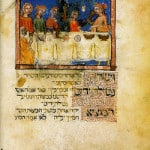

by Dr. Henry Abramson
(pic Mysterious girl at the Seder table (Sarajevo Haggadah)
The amazing story of the 700 year old Haggadah, the Muslim librarian who saved it from the Nazis, and how his children were miraculously saved by Israel.
Resplendent in deep blues, brilliant yellows and alluring reds, the 14th century Sarajevo Haggadah was created during the halcyon days of la convivencia, or “coexistence,” when Jews, Muslims and Christians lived together in Spain in relative peace.
An incomparable work of art appraised at $700 million, its wine-stained pages indicate that it was more than a precious family heirloom, it was actually used at Seder tables. It probably left the Iberian Peninsula along with the Jews exiled by the Alhambra Decree of 1492, and a Church censor’s notation dated 1609 indicates that it somehow passed the scrutiny of the Inquisition in Italy. In the late 19th century a mysterious figure named Joseph Cohen sold the precious document to a museum in Sarajevo, where it currently resides as a treasured item of the National Museum of Bosnia and Herzegovina.
Art historian Dr. Marc Michael Epstein has decoded many of the mysterious iconographic elements in the haggadah. A dog chasing a hare over the biblical verse “and they tortured us” was an expression of a medieval Jewish convention, based on a Talmudic reading of Kohelet 3:15 that God will “seek out the pursued” (the contemporary Barcelona Haggadah, by contrast, has a representation of a dog serving a hare in the Messianic future).
Some mysteries remain opaque, such as the identity of the dark-skinned woman at the all-female Seder table. Her exotic headgear and position opposite the woman of the house and lower in the frame indicate that she might be a Moorish servant, but she is seated and clearly participating in the meal. Is she a convert? Perhaps a guest? The problem is compounded by the fact that portraits in medieval manuscripts of this nature often reflect the faces of the family that commissioned the artist. In other words, this particular illumination is most likely a representation of the first owners of the Sarajevo Haggadah who felt the mysterious woman (girl?) was sufficiently important that she be included as part of the household.
Elements like these have baffled art historians, including Pulitzer Prize-winning journalist Geraldine Brooks, whose novel People of the Book is a fictionalized account of the Sarajevo Haggadah’s history.
Among the amazing stories associated with the document is that of Dervis Korkut, a Muslim intellectual who served as the Chief Librarian of the Museum during the Nazi occupation. A fervent advocate of the multi-ethnic culture of Sarajevo, he predicted that the Nazis would seize the Haggadah for the bizarre “Museum of Jewish Civilization” in Prague that Hitler had planned in future commemoration of the destruction of the Jewish people. At great personal risk, Korkut smuggled the slim book out of the Museum and deposited it with an Imam, who hid the books in the library of a mosque outside of Sarajevo, returning it after the war.
Korkut’s love for the Jewish citizens of the city extended beyond their precious Haggadah. In the spring of 1942 he hid an orphaned Jewish girl in his home, telling his wife Servet to pretend she was, perhaps like the mysterious woman in the Haggadah, a Muslim servant. In this manner young Mira Papo survived the war and emigrated to Israel, where she successfully petitioned the Yad Vashem World Holocaust Remembrance Center to recognize the Korkuts as Righteous Gentiles. A tree was planted in their honor and they received a handsome Hebrew certificate testifying to their wartime heroism.
Almost 60 years later, Sarajevo was once again engulfed in violence. During the Bosnian war, Serbs massacred thousands of Muslims in so-called “ethnic cleansing.” The Korkuts’ daughter Lamija Jaha and her husband Vllaznim fled the bloodbaths and managed to cross the border into Macedonia with nothing other than her handbag and whatever family mementos she could carry. Lost amidst hundreds of refugees in a strange land, with no one to turn to for assistance, Lamija realized one of the family heirlooms she saved was a creased photocopy of the certificate her parents had received from Yad Vashem.
Desperate, the Jahas made their way to Skopje, which had a population of some 200 Jews. They presented the document to Victor Mizrahi, the President of the Jewish community Skopje, who immediately contacted Jerusalem for assistance. Within days Lamija and her family were flown to safety and greeted at Ben-Gurion Airport by Prime Minister Netanyahu, who extended asylum to the family in recognition of the wartime work of her father, whose heroism saved the life of a young Jewish girl – and the Sarajevo Haggadah.